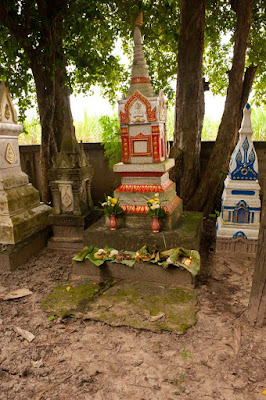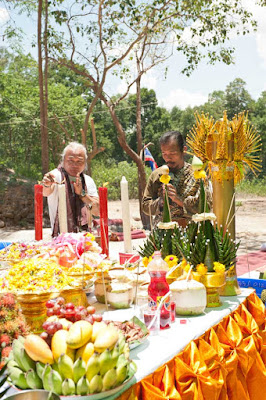 |
| Por Gae Ta Fai |
Duang and I drove out to her home village on May 1st to witness another Korb Siarn Khru ritual being performed at the Wat located just outside the village amongst the sugar cane fields. This was the third ritual that we have observed during the past three years.
The Korb Siarn Khru ritual is a variant of the Wai Khru ritual.
In a Wai Khru ceremony, devotees pay homage and demonstrate their respect for their teachers and the deities associated with their art or practice. The term, "teachers", is not restricted to the people who are employed to teach reading, writing, and arithmetic. Teachers in this sense of the word includes all those that have instructed, inspired, and trained others in a wide variety of matters.
Buddha is considered to be the greatest of teachers. There are teachers of many things such as music, dance, martial arts, astrology, traditional healing, and magic.
The Wai Khru ceremony is not a Buddhist ceremony although Buddhism is often involved in the ritual. The origins of the Wai Khru ceremony are in the Animist and subsequent influence of Brahmanism. Animism was the original religious belief system of the native peoples of Thailand and in particular the inhabitants of the region referred to as Isaan (Northeast). The history of Southeast Asia is fraught with migrations, wars, invasion, and subjugation. One of the consequences of the turbulent past was the spread of different religions and philosophies. One of the religions that spread to Thailand was Brahmanism, the precursor of Hinduism, originating in Northern India but most likely spread in Thailand from Cambodia as part of the Khmer Empire.
Rather than eliminating the former Animist practices, beliefs and rituals with the arrival of Brahmanism, the old traditions were assimilated into the new system. The same thing occurred later when Buddhism arrived from Ceylon.
This all makes for a very interesting and quite often confusing religious system which is practiced here in Isaan today. Today, 95% of the Thai people are Theravada Buddhists but a vast majority of the Thai people's religious beliefs, practices, as well as rituals are vestiges or heavily influenced by Animism and Brahmanism. The Wai Khru Ceremony is one example.
The Korb Siarn Khru ritual involves paying respects to teachers known as "Ruesi", sages and seers, who are masters of the occult (outside of ordinary knowledge). In a twist on the Wai Khru ritual, the devotees have a mask placed upon their head to transfer blessings and to link them to the lineage of the masters and deities.
The Korb Siarn Khru ceremony removes black magic spells and provides protection to the devotee.
Attending large and well known events such as the Wai Khru Ceremonies and Korb Siarn Khru Ceremonies provide opportunities for me to meet my ambition and achieve my goals in regards to photography.
I prefer the smaller, more intimate venues where there are not television cameras, reporters, or thousands or even hundreds of tourists. These events and venues, where the people are conducting rituals for their own benefit offer much better opportunities to experience and better understand the event and its impact on the local people.
Living in Thailand and being married to an ethnic Lao, gives me many opportunities to experience and photograph "extraordinary people doing ordinary things." Often I have opportunities to experience and photograph "ordinary people doing extraordinary things"
Often my wife, Duang, will get a phone call from someone in the extended family notifying her of some ritual, event, or thing that they believe that I would like to photograph. Just as new religious systems have been assimilated, I have been assimilated into Duang's extended family.
The young Monk of the Wat performed a typical offering ritual outside of the shrine at the white covered table while devotees sat in chairs underneath the pavilions. After completing this part of the ritual, he went inside of the shrine for the remainder of ceremony - the Korb Siarn Khru Ceremony.
Ruesi were and are hermit sages who spend their time meditating and developing their psychic powers - sort of like wizards. They collect magical herbs, and minerals. Using magical ingredients they produce love charms, spells and powerful amulets. The goal of the Ruesi is to help others have a happier life by telling their fortunes, conducting rituals and making spells to reduce the effects of bad karma. Ruesi also are able to ward off evil spirits. They also help people by protecting them from enemies. Certain rituals performed by Ruesi can bring good luck and fortune to their devotees. Some of the Ruesi make Sak Yants, the magical and powerful tattoos known throughout this world.
One of the most important Ruesi rituals is performed once a year is the Korb Siarn Khru - laying the Ruesi mask of the master teacher, Ruesi Por Gae, on the devotee The Korb Siarn Khru is performed during the Wai Khru Ceremony. The Siarn Ruesi mask is a full sized mask with head dress with an open mouth, three eyes, two teeth sticking out of the mouth, a moustache, and a beard. There are also masks of other deities within the Ruesi pantheon - some of them being tigers, elephants, yaks (giants) and other creatures.
Inside of the shrine there was an overhead matrix formed by stringing sai sin across the room in a checkerboard pattern. Where the sai sin intersected, separate lengths of sai sin were coiled up. As the devotees entered the shrine they uncoiled the sai sin and wrapped the free length around their head connecting them physically and spiritually to the Buddha image in the corner of the room, the Ruesi image and the items used by the Monk in the ritual. A thick sai sin dropped down from the overhead grid just to the right of the Monk conducting the ritual. He held the thick cord in his hand and several times during his incantations would violently pull on the heavy cord causing the entire grid to pulsate up and down in rhythm to his chanting. It was at this time that things started getting intense and for many people - very intense.
As part of this initial ritual which involved all the devotees as a group of roughly 20 people, the Monk would sprinkle the crowd with sacred water that had been produced during his chanting by wax dropping from two lit horizontal white candles suspended over a metal bowl of water.
In Thailand there is an often used expression of "Same, same but different" At first it is easy to snicker and dismiss such an expression. However, after living here for a while, I have developed an appreciation for the phrase. It captures some of the essence of being Thai and conveys the notion of being connected to something in a changing world. For Buddhist life is change. Nothing remains the same ... unchanged.
This Korb Siarn Khru ritual was the third that we attended and it was "Same, same but different"
The biggest difference in the ritual was the part of preparing the sacred water that is sprinkled on the devotees and attendees of the ceremony.
The water is produced pretty much in the same manner that Monks use in many of their merit making rituals.
The young Monk allowed the drippings from two white candles to fall into a converted Monk's bowl as he recited katas.
This year however was different, at the conclusion of the preparation of the sacred water, the Monk ate the fire from the candles.
The "eating of the fire" was not a carnival or street-performer feat. The Monk, a devotee and disciple of Por Gae Luesi Ta Fai was demonstrating his expertise of "Kasin Fai" - Fire Elemental Control.
Por Gae Lusi Ta Fai is a hermit wizard with a third eye. He can stare at anything and make it burst into flames.
As the ritual continued a sort of mass hysteria developed in the devotees as the volume, intensity, and rhythm of the Monk's chanting increased. Some of the devotees would have their bodies stiffen and go into spasms. They would begin to hyperventilate followed by roars, squeals, and animal sounds. Their limbs would start to flail about followed by the entire body going into convulsive spasms. The devotees who have Sak Yant tattoos adorning their body, are now in the possession of their internal animal spirits - animal spirits associated with their Sak Yant tattoos.
To be honest, there were moments when I felt very uncomfortable with all the screaming, growling, screeching, and growling along with the highly unusual movements of the possessed people about me. Once or twice I thought about bolting out of the shrine - but it was just too interesting to leave.
This was just a glimpse into the realm of the occult here in Isaan. Interestingly the occult here is related to doing good and benefiting people whereas my previous view of the occult in the West was that it was related to doing evil.
There is always something to learn and experience no matter where you are or how old you are if you are only willing to get off the beaten track and interact with the ordinary people.
If you have seen it before, there is always the opportunity to better understand and gain greater knowledge. As often is the case, there will be more than sufficient "Same. same but different" to also keep it interesting.


























































